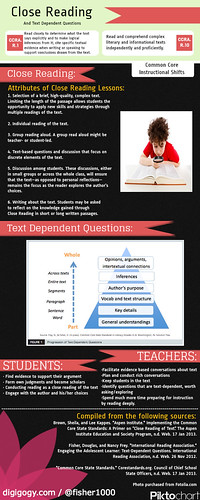3 CCSS-Friendly Digital Tools for Teaching
In the next few weeks, Janet Hale and I will have our newest book published by ASCD, Upgrade Your Curriculum: Practical Ways to Transform Units and Engage Students.
We will very soon be launching a new ASCD Edge Group and Discussion Board around the book to discuss improvements in instructional practice and design. We also want to hear the awesome ideas of all the educators who would like to engage in a dynamic multi-media conversation!
In the book, we discuss different lenses and considerations through which you can view your current curriculum for a particular upgrade. This blog post is honing in on two upgrades: technology integration and Common Core alignment.
The Common Core alignment relates to a pair of anchor standards for reading: #1 that asks students to read closely, and #10, that asks that students read and comprehend complex literary and informational texts. For the technology lens, I’ve been playing with a few new web tools and wanted to share some ideas for task-focused instruction.
Additionally, when I refer to “upgrades,” I’m speaking of a two-pronged approach, looking both for learning AND engagement. Effective instruction comes from a balance of these two considerations and while I know they can be somewhat subjective, I am, in general, looking for more student-centered opportunities than teacher-led “to-do” lists.
It’s always worth reminding ourselves that it’s the task that matters, not the tool. However, I think it’s important to build a repertoire of tools so that you and your students can choose the right one for the task.
So, in the context of adding tools to your toolboxes and doing so with specific Common Core ideas, I’d like to share three new tools that I’ve come across recently that can help with curriculum upgrades.
Smore
Smore allows a user to create flyers with embedded color schemes, fonts, and templates. I used it initially to create handouts for a workshop I was doing and quickly figured out that I needed to prioritize my information so that the message I was sending would fit on one printed page. I created a Smore flyer for this blog post around Text Complexity, specifically considering Reader and Task, from the Common Core document. Here’s the example:
I liked Smore for several reasons and see several opportunities for specific tasks/upgrades using this tool. For one, if students are visualizing their learning using something like this, it promotes eye-catching design. Brain based instructional strategies work because they are different, creating “mental glue” to help the brain retain information. Visuals stick better than text and using a tool like Smore will help students own their learning.
Also, if students are writing about text, specifically after “close reading,” this might be a good tool to use for emphasizing important comprehension points or prioritizing the information they may potentially share. In fact, how awesome would it be for students, perhaps in pairs, to prioritize different pieces of the puzzle, with some focusing on text structure, some on vocabulary, some on connections to other texts, some on text based conclusions, etc. This could help establish new audiences, purposes, and tasks as students make their own choices and ultimately help teach each other! (With sideline coaching from the teacher, rather than direct instruction.)
Piktochart
Like Smore, Piktochart is a visualization tool. However, its specific purpose is to help the user create an infographic. Infographics are visualizations of information or data — you’ve probably seen some…they’ve gone viral in the last several years. There’s a really cool Flickr Group that collects educational infographics that you should check out! Piktochart lets your students create these awesome visualizations without first acquiring high-end graphic design skills.
I think infographics are where it’s at right now in education. It’s vital for students to be able to think critically about data and draw conclusions. Infographics also offer an opportunity for us to explore integrating subjects such as math into other content areas. The Piktochart I created is about Close Reading and Text Dependent Questions, both of which are represented in the instructional shifts related to the Common Core in ELA. The one I’ve created here is text heavy, as I was just trying out the tool, but it excites me to think what kids could do with this. I found the interface and dashboard easy to use and navigate, and I went from complete novice to finished product in about 45 minutes. Next time, it won’t take half so long. Ease of use is high up on my list when it comes to web tools, and this one is as easy as they come! Here’s the example I created:
Yapp
The last tool I want to add to your toolboxes today is Yapp. I’ve been using Yapp for several months now, and it became the basis for one of the technology upgrades that Janet and I advocate in our new book. Yapp is a tool that lets you easily create your own App for a digital device. Here’s a short video tour:
I’ve used it to create Apps for events such as conferences, to collect information for a local library, and most recently, to create an App that lets me share all of my resources for Text Complexity based on a LiveBinder I created back in November. You can access the App by navigating, through your internet browser, to the following address on your digital device:
Note that you may need to install YappBox onto your device if you have any trouble with the link itself.
In the book, Janet and I talk about Learning and Engagement around students creating apps. There are certainly a number of ways to go about this, but Yapp is a good starting point. Right now in classrooms, teachers are clamoring to find apps for the various digital devices they use. This translates, a lot of times, into teacher-selected, tool-based learning scenarios rather than student-centered, task-based scenarios. Now that teachers have had some “play time” in the first decade of the 21st Century, we’re ready to shift the focus to thinking, and the ownership of the learning back to the students. If students are CREATING, and making authentic choices about what to include in an app and how to share and amplify it, then they are working at the highest levels of Bloom’s and absolutely owning the learning.
Put your toolbox to work
So, to recap, adding tools to your toolbox is valuable and necessary, even though the goal is to work toward task-based opportunities. Learning and engagement are important and must be considered together for effective learning. Also, there are several lenses through which we can explore potential upgrades to the work we are currently doing.
I’ll be exploring more of these lenses with posts at my ASCD Edge blog as we lead up to the launch of the book in early March. If any readers would like to join Janet and me in Chicago at the ASCD conference, we’ll be exploring what it means to Upgrade Your Curriculum in person. You can also use the Twitter Hashtag #UpgradeYC to interact online right now!
Michael Fisher is a former middle grades teacher who is now a full-time author, educational consultant, and instructional coach. He works with schools and districts around the country, helping to sustain curriculum upgrades and integrate instructional technology. He specializes in the integration of research-based instructional strategies to facilitate transformations of curriculum design, instructional practice, and professional collaboration, currently around 21st Century Fluencies, Common Core integration, and all that modern learning entails. Michael is a member of the Curriculum 21 Faculty and is an active blogger who writes often for the Curriculum 21 Ning (curriculum21.ning.com) and ASCD’s Edge Social Network (http://edge.ascd.org). His web site is The Digigogy Collaborative (digigogy.com) and he can be found on Twitter (@fisher1000).


































Excellent article Michael! Thank you very much for the time you devoted to share all these tools with us. I agree that visual aids are going to make a great difference~ and people like you! Sincere best to you in all you do!
These are also great tools when considering the Universal Design for Learning. Thank you for sharing! I look forward to your ASCD group launch.